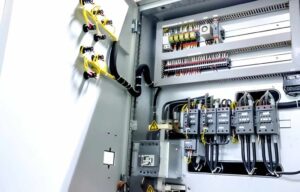MCB vs MCCB In today’s world, where electricity plays a crucial role in everyday life, ensuring safety in electrical circuits is essential. One of the most effective safety measures is the use of self-controlled electrical switches, which protect electrical appliances from sudden power surges and help prevent accidents. Since the early 20th century, circuit breakers have been widely used to safeguard electrical systems from overloads and short circuits. Over time, technological advancements have led to the development of more advanced circuit breakers, including Miniature Circuit Breakers (MCBs) and Molded Case Circuit Breakers (MCCBs).
MCBs and MCCBs fall under the category of circuit breakers, playing a critical role in electrical protection. They are widely used in residential, commercial, and industrial electrical systems, as well as in photovoltaic power systems. While these two devices may appear similar at first glance, they serve different purposes and are designed with unique features to meet the varying requirements of electrical systems. These differences lie in aspects such as their construction, capacity, tripping characteristics, and breaking capacity.
This article will first explain what MCBs and MCCBs are, followed by a detailed comparison of their differences.
A Miniature Circuit Breaker (MCB) is a compact, low-voltage circuit breaker primarily used to protect electrical circuits from overloads and short circuits. MCBs are commonly installed in residential buildings, light commercial settings, and small industrial applications.
MCBs typically operate in less than 2.5 milliseconds during a short-circuit fault and within 2 to 120 seconds during an overload condition.

A Molded Case Circuit Breaker (MCCB) is a larger, high-power circuit breaker designed for industrial and commercial applications. MCCBs have adjustable settings and a higher breaking capacity compared to MCBs, making them suitable for large-scale electrical installations.
MCCBs contain bimetallic contacts that expand when exposed to excessive current, causing the breaker to trip and disconnect the circuit from the power source, thereby preventing damage.
Both MCBs and MCCBs are vital for ensuring electrical safety, but they must be chosen based on the specific needs of the electrical system.
| Feature | MCB | MCCB |
|---|---|---|
| Breaking Capacity | Up to 10 kA | Up to 100 kA |
| Rated Current | Below 100A | 10A – 2500A |
| Tripping Characteristics | Fixed | Adjustable |
| Size | Small and compact | Larger and more robust |
| Applications | Residential, light commercial | Industrial, commercial, heavy-duty applications |
| Cost | Lower | Higher due to advanced features |
| Maintenance | Minimal maintenance, sealed design | Requires periodic inspection and maintenance |
MCCBs have a much higher breaking capacity than MCBs, meaning they can handle larger short-circuit currents without getting damaged. While MCBs typically have a breaking capacity of 10 kA or less, MCCBs can interrupt currents up to 100 kA.
MCBs are compact and space-efficient, making them ideal for household and small commercial applications. In contrast, MCCBs have a larger and more rugged design, built to withstand high-energy electrical loads in industrial environments.
MCBs have a fixed tripping characteristic, meaning they trip immediately when an overload or short-circuit condition occurs. MCCBs, however, have adjustable tripping characteristics, allowing for precise protection and flexibility in industrial applications.
MCBs are best suited for low-voltage applications such as residential buildings, offices, and small-scale commercial setups. MCCBs, on the other hand, are used in industrial settings, power distribution networks, motor control centers, and large commercial buildings.
Due to their complex internal mechanisms and higher-grade materials, MCCBs generally cost 25-50% more than MCBs with similar current ratings.
MCBs typically have a sealed, maintenance-free design and can last 10 to 15 years under normal operating conditions. MCCBs, however, require regular inspections and preventive maintenance every 3 to 5 years to ensure proper functioning.

Before MCBs and MCCBs became widely available, earlier technologies were used for circuit protection. These included:
The development of MCBs and MCCBs revolutionized circuit protection by providing faster response times, compact designs, adjustable settings, and the ability to reset after tripping, making electrical systems much safer and more reliable.
Both MCBs and MCCBs play a crucial role in electrical safety, protecting circuits from faults and ensuring stable power distribution. The choice between the two depends on the specific requirements of the application:
When selecting the right circuit breaker, key factors to consider include rated current, breaking capacity, tripping characteristics, and durability to ensure the best protection for electrical equipment.
By understanding the fundamental differences between MCBs and MCCBs, you can make an informed decision to enhance the safety and efficiency of your electrical system.